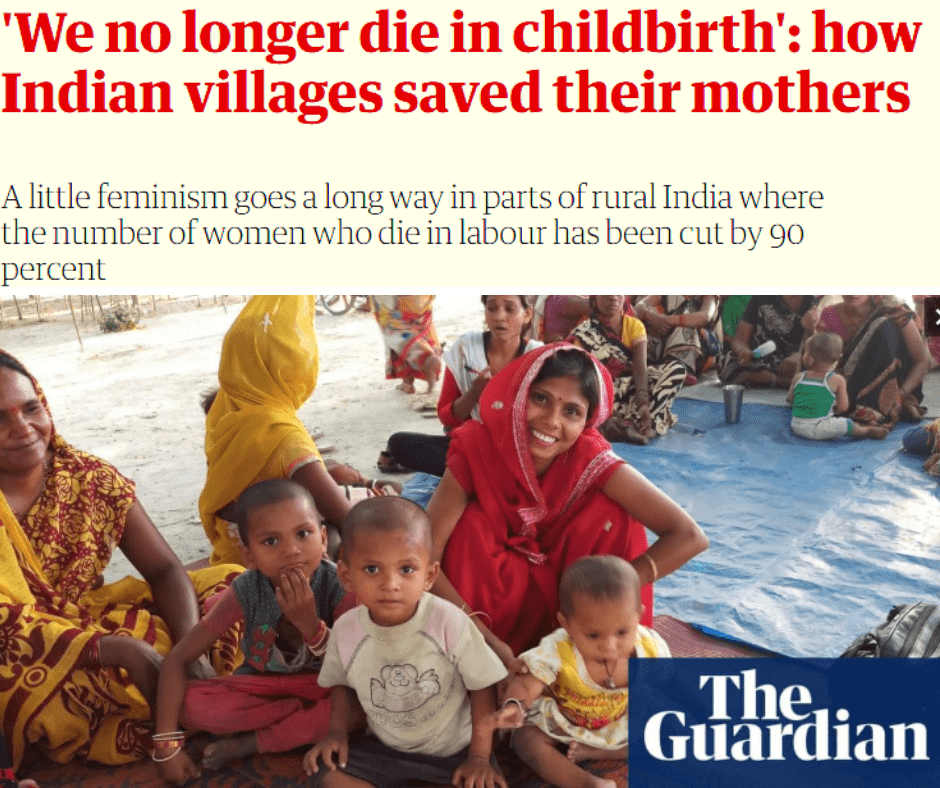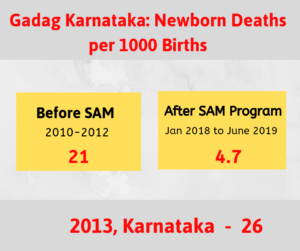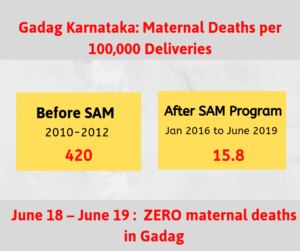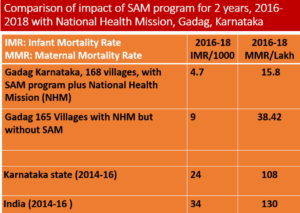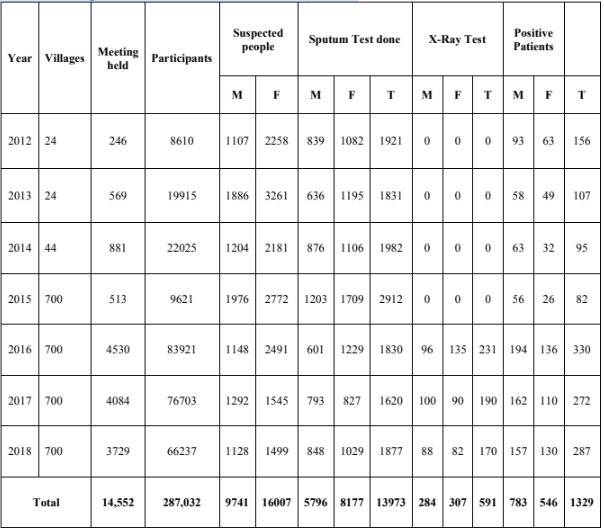Impact
SAM has operated in 3200 villages and covered 6.2 million people
At present, SAM is working in 3200 villages and 5 urban slums.
- 2008: Maternal child health program in Sultanpur, Amethi & Raebareli (UP)
- 2012: Expanded to Gadag, Karnataka
- 2013: Expanded to Dharwad, Karnataka
- 2013: Started TB Control in Amethi, UP
- 2013: Started population stabilization program in Amethi, UP
- 2014: Expanded to Hospet, Karnataka
- 2014: Expanded to Jaunpur (UP),
- 2015: Expanded to Nizamabad, Telangana
- 2016: Expanded TB control to 700 villages in Amethi, UP
- 2018: Expanded to Varanasi Urban Slums.
- 2019: Expanded to 1400 villages, Bahraich, UP
- 2019: Expanding to 150 villages, Muzaffarpur, Bihar
- 2020 Collaboration with Mahila clinics to prevent breast and cervical cancer.
Each program starts with a baseline and finishes with an end-line evaluation. SAM defines objectives, activities, outputs and outcomes before the start of the program. They measure monthly progress against all these parameters. Process of measuring impact is a four step process:
- Data Collection at community level: The field workers collect data during house visits and community meetings. They upload it on a smartphone.
- Data review at block level: Field officers collate and review data every month at a block level. They validate it by through client interaction.
- Data validation at district level: SAM validates data through a monitor and evaluation protocol which includes field visits, focus groups and comparison with public health data. SAM compares outcomes and impact with similar programs run by the government and other private organizations.
- External agency evaluation: Periodically, SAM engages external agencies to evaluate its work. The funding partners also send external evaluators to check the progress and impact.
- SAM has trained 37,000 volunteer health activists who live in the villages and are available to the community. SAM has directly impacted over 1,150,000 million people through maternal, child health, Population stabilisation and TB control programs.
- Through maternal, child health and population stabilisation programs, SAM has directly impacted: 530,000 women and over approximately 100,000 infants. SAM follows all (100%) pregnant women in the villages and has reduced maternal mortality by 90% and infant mortality by 60%.
- In some places SAM have done even better. Example: In the past 6 years, in 167 villages of Gadag in Karnataka, maternal mortality rate has decreased to 15.8 from 364 and Infant mortality rate has decreased to 5 from 46.
- Through population stabilisations program, marriage of girls under 18 years of age has decreased to almost zero. Contraceptive use has increased from 28% to 62% and supply chain management has reduced the unmet need of contraception from 10.8 % to 2% . Since 2013, TB control program has been running in 700 villages. 287,042 people have participated in 14,552 community meetings. 13,973 people have had sputum tested. Sputum was positive for TB in 1329 people and 14 had multiple drug resistant TB.
- All received supervised treated. SAM has directly helped with education and surveillance of 130,000 contacts of TB patients and helped another 317,000 community members with awareness program. TB detection rate has improved 3.7 times.
- SAM estimates that approximately 0.9 to 1 million people, who did not actively participate in its programs, became aware of the benefits from those who attended our programs.
- Women feel empowered, which has opened their minds to many choices in life. They express their opinions freely. Men and elderly women, who were suspicious and objected to their women attending public meetings, have mellowed their resistance and have even become enablers.
- Girls attend school more regularly and the number of girls attending college has increased. Adolescents participation has increased. Public health system and their workers are more responsive to public demand. Local elected politicians are responsive.
- Worked in 3200 villages since 2008
- Trained over 37,000 volunteer health activists
- Reduced maternal morality by 95%
- Reduced neonatal mortality by 60%
- Increased delivery in hospital to 99%
- Immunization against Tetanus increased to 90%
- Increased TB detection by 300%
- Contraceptive acceptance increased by 220% from 28% to 62%
- Reduced girls marrying before 18 years close to
ZERO
- Maternal Mortality Reduction
- Infant Mortality Reduction
- Stabilization of Population
- Tuberculosis Control
- Under 5 Mortality Reduction
- Adolescent Health
- Malnutrition
- Breast and Cervical Cancer Detection
- District Amethi, UP
- Started 2008
- Total villages: Over 700
- Total Population: 1,500,000.
- Population covered: 1,300,000
- Population coverage: 87% of total
- Programs:Maternal Child health ; Population stabilization; TB control
- District Gadag, Karnataka
- Started 2012
- Villages covered : 168
- Population covered approx: 500,000
- Program Maternal Child health
- District Varanasi, UP
WE ARE WORKING IN 5 SLUMS.
Population 25000
Will expand to 10 more slums in 2020
Program : Infection control , immunization, nutrition and reducing under 5
years child mortality. - District Muzaffarpur, Bihar
- Started 2019
- Population to be covered 400,000
- Covered villages 152
- Programs: population stabilization , nutrition, encephalitis control
- Bahraich , UP
- Started 2019
- Population to be covered 3.4 million ( 34 Lakh)
- Covered villages 1400
- Program: population stabilization
- Karnataka
Year Total Number Of deliveries Number of MM MM/Lack Number of Infant death IM/1000 2013-14 4284 08 141/100,000 65 15.47/1000 2014-15 6512 08 123/100,000 75 11.53/1000 2015-16 7307 03 42/100,000 59 8/1000 2016-17 6057 01 25/100,000 38 6.35/1000 2017-18 6519 01 15.4/100,000 25 4/1000 2018-19 6402 01 17.2/100,000 27 4.21/1000 - Uttar Pradesh
After 3 Years
- 90 % reduction in maternal deaths
- 57% reduction in neonatal deaths
- 99% increase in institutional deliveries
- 95% increase in girls marrying after age of 18 years.
- 53% increase in modern contraceptive use among targeted & eligible couples
SAM – 2017 Impact
Impact on Maternal Mortality Rate (MMR) &
Infant Mortality Rate (IMR)MMR
Per 100,000 deliveriesIMR
Per 1000 births700 villages, with SAM program
Jan 2017 to Dec 2017
5052 deliveries178 8 Overall UP State 2014-15 stats 258 68
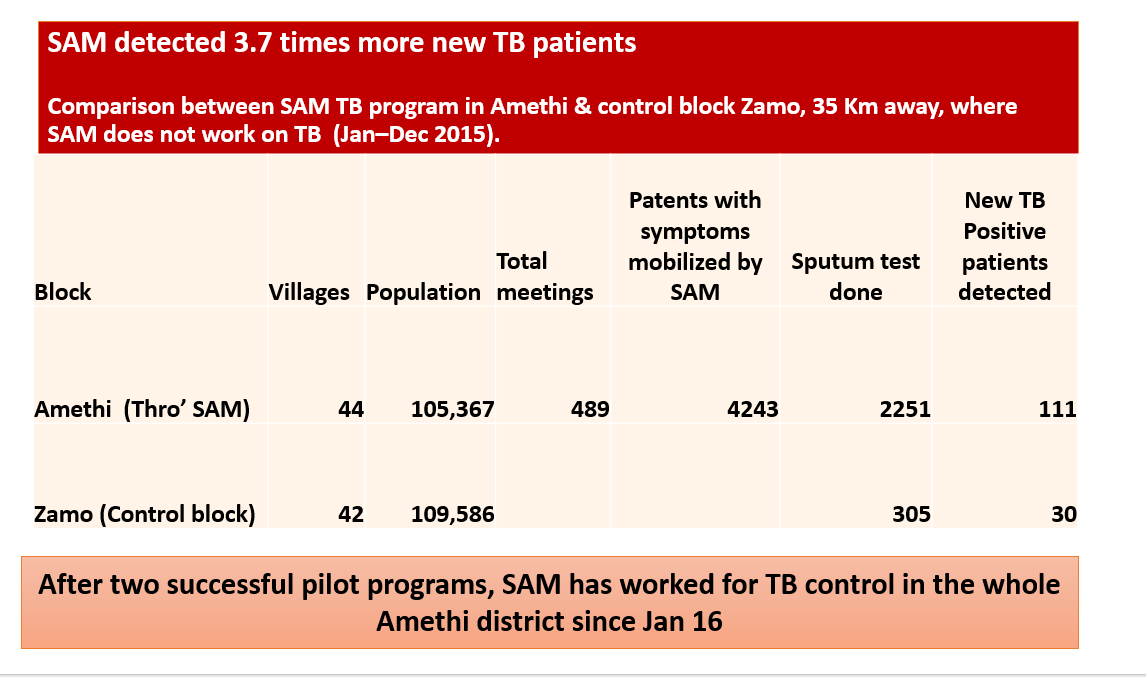
Validation of Impact in Gadag:
We validate impact by internal analysis and external evaluation. We conduct studies to validate our data. As example, we conducted the total review of work done in 167 villages of Gadag, Karnataka since the beginning of the program and compared it with 162 villages of the same district Gadag, where we don’t work and also compared it with an adjoining district Haveri.

Impact analysis; Number of training sessions for staff health workers in Gadag:

Impact on maternal mortality reduction in Gadag since 2013

Comparison of SAM data on maternal mortality rate (MMR) with similar programs.

We saw a steady fall in maternal mortality from 2011 till 2017 when it hit a plateau. It dropped from
MMR 345 in 2011 to 64 in 2016. Then there was a spurt. In 2017, there were 16 maternal deaths among
14084 pregnancies.
We conducted the root cause analysis and found deaths happened in the institutions or at home, which
had no provisions of blood transfusion or an obstetric surgeon. We changed our protocol. Since then, all
pregnant women have been directed to deliver in public or private hospitals, which have obstetric
surgeons and blood transfusion available. The result is dramatic. In 2019 maternal mortality was 62
among 6502 child births.
Impact on maternal and Infant mortality in Amethi:

Population Stabilization program Internal validation of impact in Amethi. Jan 18 to Dec 18
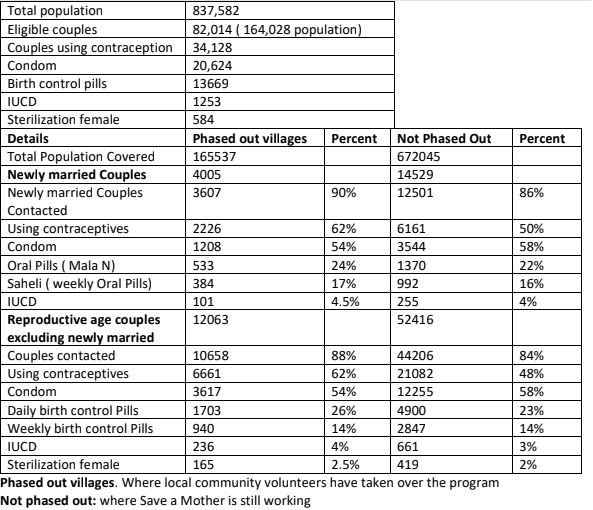
Tuberculosis (T.B.) Control Program in Amethi district:
Tuberculosis control program was piloted by Save A Mother Foundation ( SAM) in 5 blocks of Amethi district from April 2012 to December 2013.
With some modification of the strategy, SAM expanded the T.B. control program to the remaining blocks of Amethi district from January 2015. SAM has a dedicated staff for community mobilisation, capacity building, training, convergence and coordination with Govt. health department. SAM uses its experience of Effective Social Persuasion (ESP) to actively seek TB patients from the community and send then for sputum tests. SAM field facilitators counsel the T.B. positive case to start the treatment at the earliest and follow them during treatment to ensure complete treatment.
T.B. control program implementation strategy:
- Community Mobilisation.
- Strengthening Change Agents called, Swasthya Sakhi, to cater the entire village population and identify potential T.B. patients.
- Capacity building of stake holders including Health activists, Swasthya Sakhi, Arogya Sakhi, and public health workers.
- Individual counselling of suspected and confirmed TB patients
- Convergence and coordination with Government and other NGOs.
TB control program till July 2019
- 287,042 participated in 14,552 community meetings
- 13,973 sputum tested
- 1329 sputum positive TB and 14 MDR TB treated
- Directly helped 130,000 contacts of TB patients
- Helped 317,000 community contacts with awareness
Progress Report of 2018 (January 2018 to Dec. 2018)
| Particulars | Numbers |
|---|---|
| Total No. of open meetings held | 3729 |
| Total No. of Participants participated in the meetings. | 66237 |
| Total No. of suspected T.B. persons individually motivated | 2627 |
| To. No. of Motivated persons reached to hospital | 2023 |
| Sputum test done | 1877 |
| X-ray done of total no. of persons | 170 |
| Total No. of Positive patients in the year 2018 | 287 |
| Total No. of positive patients Treatment started | 287 |
| Total No. of Patients in 1st category | 262 |
| Total No. of Patients in 2nd category | 14 |
| Total no. of patients in MDR | 11 |
| Follow up by SAM staff | 287 |
| No. of patients died during treatment | 08 |
| No. of patients drop out | 26 |
| Total No. of patients cured in this year | 134 |
| No. of TB. Patients under treatment | 119 |
